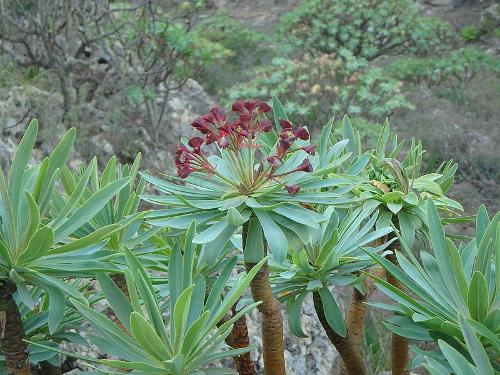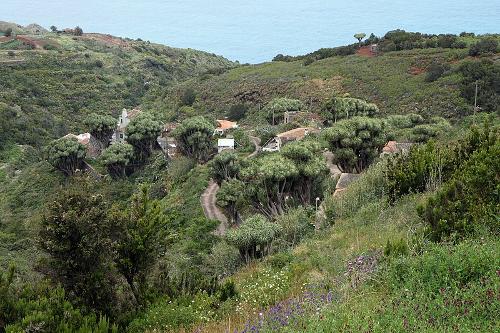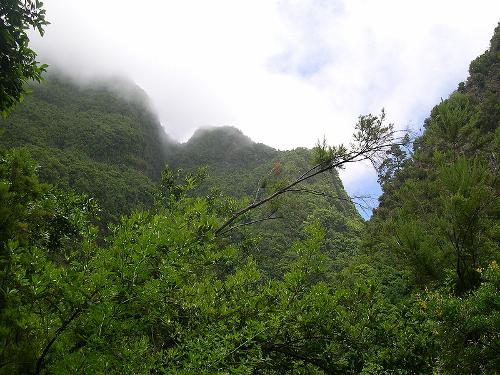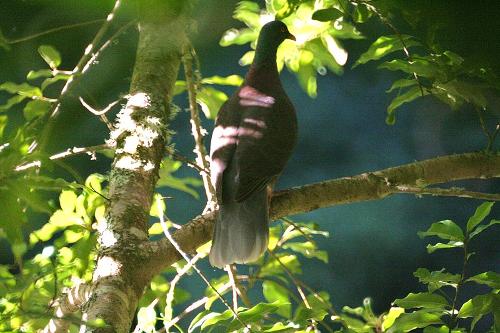LA PALMA
Plants and Animals

Plants and Animals

Popular destinations SPAIN
| Andalusia | Catalonia | Costa blanca |
| Costa brava | Costa del sol | El hierro |
| Formentera | Fuerteventura | Gran canaria |
| Ibiza | La gomera | La palma |
| Lanzarote | Mallorca | Menorca |
| Tenerife |
Plants and Animals
Plants
La Palma is also called the 'green island', and this is mainly due to the Canary Pine, which covers about a third of the island.
Botanists have established that there are around 800 plant species on La Palma, of which around 70 are endemic and do not occur on the other Canary Islands. One example is the Aeonium, a succulent, of which there are eleven unique varieties on La Palma. The following plants, among others, can be seen on La Palma: taginaste, vinagrera, codeso, verode, red flowering tabaiba and crowned candelabra.
 Red Flowering Tabaiba, La PalmaPhoto: Daniel Cahen CC 4.0 no changes made
Red Flowering Tabaiba, La PalmaPhoto: Daniel Cahen CC 4.0 no changes made
The lowest zone from the coast to about 600 metres altitude is often hot and dry, and therefore particularly suitable for succulents. Most characteristic of this vegetation zone are the candelabra species, which have developed here into shrubs of sometimes two metres high. The candelabra spurge has long, columnar stems and therefore looks like a cactus species. Another important group of succulents are the various species of Aeonium, eleven of which are endemic to La Palma. The milk thistle is also endemic to La Palma and, like the Canarian lavender, drops its leaves in the summer to resist drought. On the transition to the next vegetation zone you will find, among others, dirty trees, gorse, Canary palm and the famous dragon tree, in fact a lily species that can reach hundreds of years of age. Nowhere else in the Canary Islands are so many of these trees left as in the north and northwest of La Palma.
 Dragon Blood Trees, La PalmaPhoto: H Zell CC 3.0 no changes made
Dragon Blood Trees, La PalmaPhoto: H Zell CC 3.0 no changes made
Near La Tosca is the largest dragon blood tree 'forest' of the entire archipelago, say twenty specimens. In the 'wet' northeast, the dense, evergreen laurel forest can be found above six hundred metres. Experts can distinguish four species: Azores laurel, Madeira mahogany, Canary laurel and the 'tilo'. Large ferns and climbing plants grow between the laurel trees. The rare pininana, a very large species of snakeweed that is endemic to La Palma, grows in open spaces.
Above the laurel forest zone, the drought-loving Fayal-Brezal vegetation type can be found, with a lot of tree heaths and gale shrubs, as well as Canary holly and tagasaste, a white, butterfly-flowered shrub.
The flora on high mountain peaks consists of specialised plant species that can withstand extreme temperatures and drought. Characteristic are their low, pillow-like growth and their small, usually hairy leaves. The gorse-like Adenorcarous viscosus is common; the Palma violet is almost extinct.
In winter, under pines in the south of the island, orchids with fragrant flowers, Habenaria tridactylites, bloom. In addition to all kinds of ferns and mosses, the Canary ranunculus and the Canary stork's broom can be found here.
Canary Island willows can only be found on Madeira and not on the Canary Islands. On humid basins, the ubiquitous cistus grows as well as the affodil, which bears long, white bunches of flowers in the winter months.
 Bosque de los Tilos, La PalmaPhoto: Luv Viatour CC 3.0 no changes made
Bosque de los Tilos, La PalmaPhoto: Luv Viatour CC 3.0 no changes made
The Bosque de Los Tilos (tilos = linden tree) is the largest connected forest area in the whole of the Canary Islands and is a Unesco World Biosphere Reserve. It is a so-called laurasilva forest with lime trees, laurel trees, myrtles, ferns and a rare species of spurge, Euphorbia mellifera. The giant leaves of Woodwardia radicans, the largest fern species in the Canary Islands, can also be seen here.
The name Los Tilos is derived from a species of laurel that has almost disappeared everywhere, but is only found in large numbers here. In 1998 the original biosphere reserve, which covered only 511 ha, was enlarged to 13,000 ha.
La Palma also has a large number of imported (sub)tropical species, including mimosa, hibiscus, bougainvillea, bird of paradise flower, Christmas rose, disc cactus, agave, Indian laurel and oleander.
Animals
Dogs and goats are the most common mammals on La Palma. There are also rabbits, bats and the Barbary sheep or 'arruí', of which there are still a few hundred in the national park.
 Paloma Rabiche, La PalmaPhoto: DrPhilippLehmann CC 3.0 no changes made
Paloma Rabiche, La PalmaPhoto: DrPhilippLehmann CC 3.0 no changes made
There are 36 species of breeding birds on La Palma. The graja is a crow-like bird, with a typical curved red bill. Rare are two species of laurel pigeon: the paloma rabiche and the paloma turqué. Known from the Canary Islands is the wild European canary.
The only poisonous animal on La Palma is a certain type of centipede.
The many species of butterfly are notable, including the lesser monarch butterfly, the tiger blue, Canary atalanta, Canary spotted sand moth, brown sand moth, thistle moth and reseda witch.
Sources
Canarische eilanden
Van Reemst
Evers, K. / Canarische eilanden : Tenerife, La Gomera, El Hierro, La Palma, Gran Canaria, Fuerteventura, Lanzarote
Gottmer
Klöcker, H. / La Palma
Deltas
Lipps, S. / Wandelgids La Palma
ANWB
Murphy, P. / Canarische eilanden
Kosmos-Z&K
Renouf, N. / Canarische eilanden
Kosmos-Z&K
Rochford, N. / Wegwijzer voor La Palma en El Hierro : een landschapsgids
Sunflower Books
Schulz, H.H. / La Palma
Van Reemst
Valk, T. / Wandelgids La Palma : 16 wandelroutes
Elmar
CIA - World Factbook
BBC - Country Profiles
Copyright: Team The World of Info